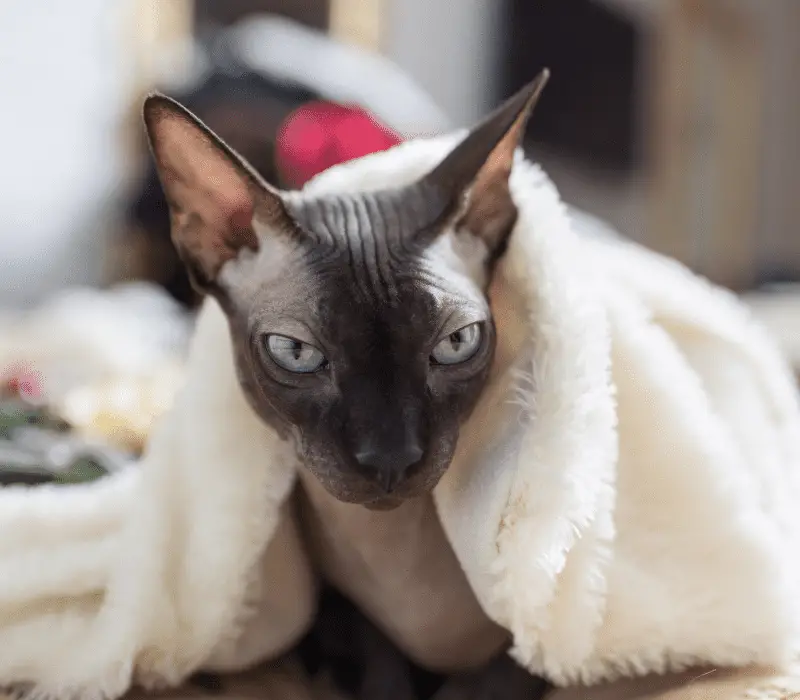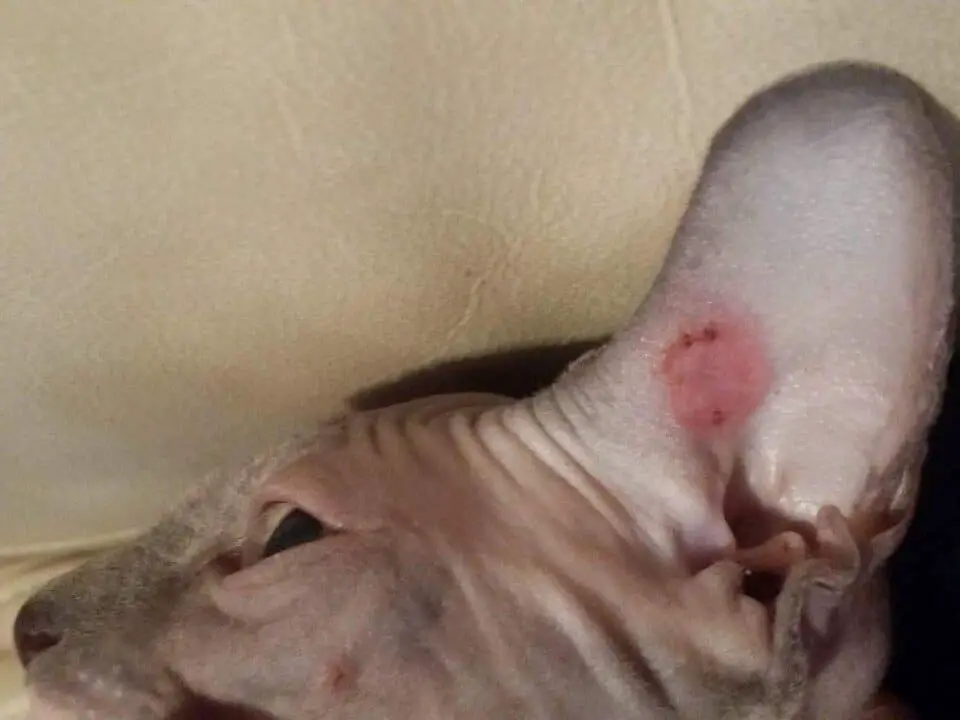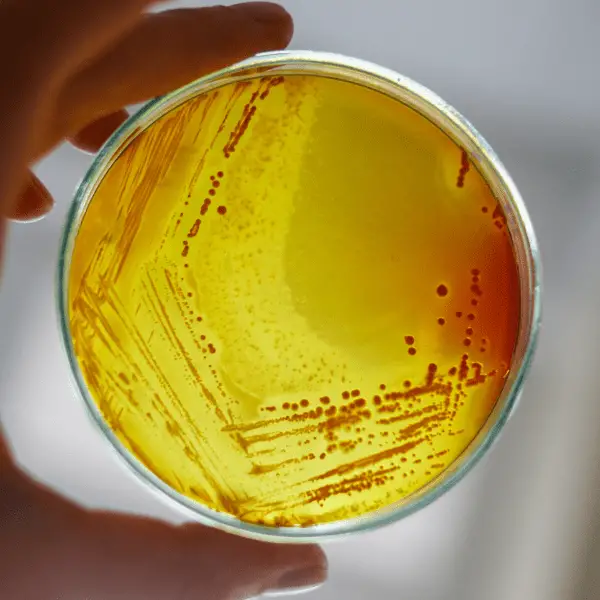This article contains affiliate links, and we may earn a commission at no cost to you if you choose to purchase through these links. I never recommend products that I do not trust or will not advise my veterinary clients and patients to use.

Ringworm (feline dermatophytosis) is a superficial, contagious fungal infection of the skin, hair, and nails. Despite the name, ringworm has nothing to do with worms but rather with many different types of fungi that cause similar lesions. In cats, the most common culprit is the fungus Microsporum canis.
Ringworm is zoonotic, meaning it can be transmitted to and affect humans via pets in the home.
Are Sphynx Cats More Susceptible to Ringworm?
Sphynx cats, like most other animals and humans, can get ringworm; however, sphynx cats are not more susceptible to getting ringworm compared to other cat breeds.
Sphynx cats tend to have very oily skin, and it is therefore recommended that proper skin care of your sphynx cat includes weekly baths to maintain clean, healthy skin. The use of warm water and a veterinarian-approved medicated pet shampoo are often required to keep the skin of your sphynx in optimal condition.
Because of the nature of sphynx skin and the ongoing upkeep necessary, sphynx cats are a lot less susceptible to ringworm. However, in multi-pet households (other haired cats and dogs), the likelihood of your Sphynx getting ringworm may increase.
Cats with fur and especially very long fur, are more susceptible to ringworm because the fungal spores are easily trapped in the long hair strands and are very difficult to remove.
Kittens of any breed under the age of one are the most susceptible to ringworm because their immune systems are still developing.
Pet Vet Tip: To read more on common skin conditions in sphynx cats and how it may differ from ringworm, have a look at this article.
How Can A Sphynx Cat Get Ringworm?
Ringworm is highly contagious and is most commonly spread through contact with other infected pets in a multi-pet household, as the fungal spores are distributed via shed hair, nails, and skin.
Fungal spores can also become trapped within bedding, towels, carpet, plush toys, food bowls, grooming tools, and other environmental surfaces and can remain dormant for up to 18 months.
It is important to note that the amount or level of contamination is a big factor in the development of a ringworm infection, as is the age of the animals and the level of immunity.
What Does Ringworm Look Like On Sphynx Cats?
Ringworm is sometimes challenging to detect in cats because the lesions may be mild, unnoticeable, or not follow the conventional “ring pattern” and be mistaken for something else.
Ringworm fungi feed on keratin, which is the protein in the outer layers of hair, nails, and skin.

The most common lesions seen are:
- Scaly texture
- Dandruff
- Sore, red, and crusty patches
- Circular, thickened patches of skin
- Ring-like lesions
Some Sphynx cats may present with breakouts that look like chicken pox or even as simple as, what appears to be a few pimples.
Infection of the claws may occasionally occur, causing the claws to be rough and pitted. They may also become scaly and become deformed if left for a while.

It is always advised to seek veterinary assistance as soon as possible when you notice any kind of strange skin lesion on your cat.
The main sites for these skin lesions are usually on the head, forehead, and along the bridge of the back, chest, and forelegs, but ringworm lesions can appear anywhere.
Ringworm can also cause generalized skin disease, affecting the entire body, such as Urticaria Pigmentosa. Urticaria Pigmentosa is the proliferation of mast cells in the skin in response to an inflammatory reaction, causing widespread papules, macules, and hives.
How Can Ringworm Be Diagnosed in Sphynx cats?
Ringworm in cats can be diagnosed by using a special UV light called a Woods lamp. When the skin is examined under the Wood’s lamp, the ringworm will glow with a green-yellow fluorescence. Not all cases show the characteristic glow, and sometimes, different species or strains of ringworm will not show at all.
The most accurate way to diagnose ringworm is by a culture of the fungus in a laboratory. Your vet will take skin scrapings and some hair samples and send them to the lab to be tested. A positive culture result can be obtained within a few days, but it may also take up to three weeks for some fungal spores to grow.
Several other causes may cause any form of a skin lesion in your Sphynx cat, so your vet might recommend an array of additional tests to rule out other skin conditions.

How is Ringworm Treated in Sphynx Cats?
A common treatment protocol is to use a combination of topical treatment and systemic oral treatment.
1. Topical treatment:
Creams and ointments containing miconazole, terbinafine, or clotrimazole should be applied to areas of the skin which are affected by ringworm. Additionally, chlorhexidine and miconazole-based shampoos can be used twice a week.
After shampooing your cat or applying cream or ointment to the skin, you should wash your hands thoroughly with soap and water, sanitize all surfaces your cat came into contact with, sanitize any instruments, and machine wash the towels with hot water and detergent.
A shampoo such as the Veterinary Formula Antiseptic & Antifungal Shampoo contains the antifungal Ketoconazole that is effective against ringworm. However, shampooing with this shampoo alone may not be enough to clear a ringworm infection. The Vetoquinol Clotrimazole Antifungal Solution drops can be used twice daily for a minimum of two weeks on suspected ringworm lesions.
2. Systemic oral treatment:
The most commonly used drug is itraconazole or terbinafine. This treatment can last for up to six weeks; however, longer therapy is sometimes required.
Your veterinarian will advise you on the dosage and interval frequency you should follow when medicating your cat. The full course of treatment must be administered to your cat unless instructed otherwise by your veterinarian. Stopping treatment too soon can result in the recurrence of the fungus.
Remember To Clean The Environment
Environmental cleaning is also an important part of the treatment of ringworm in your cat. Numerous microscopic fungal spores are released into the environment and within your home, and infection of other animals in the home or even you can occur through contact within a contaminated environment.
You should damp mop and vacuum all rooms and areas accessible to your cat daily. Fungal spores can also be killed with a solution of bleach to clean the floor or wipe surfaces. Dilute 500ml (about two coffee mugs) into a gallon (4 liters) of water and use where ever practically possible.
Your cat will have to undergo regular tests to ascertain whether the treatment is effective or not or to determine if your cat is still infected.
Two consecutive negative cultures for ringworm will indicate that the treatment was successful.
How to Prevent or Stop the Recurrence of Ringworm
As the saying goes, “prevention is better than cure,” and this, too, is the case with ringworm in your household.
Here are a few ways to prevent ringworm infection or to stop the recurrence:
- Quarantine new animals brought into the home and observe for any skin lesions that may develop (this is good practice in general).
- Quarantine any animal undergoing treatment for ringworm
- Disinfect surfaces after treating a sick cat or other animals in the home
- Frequently inspect the skin of your cat and all other pets in the household
- Wash pet bedding often with hot water and detergent
- Vacuum carpet and sofas regularly
- Wash floors with a bleach solution
- Keep animals (especially dogs) out of gym bags and dirty gym clothes
- Human clothing and bedding should also be washed regularly with detergent
- Seek veterinary or medical care for ringworm or similar symptoms as soon as possible.
References:
- Marcin, S. et al. (2020) “Urticaria pigmentosa due to microsporum canis infection in a sphynx cat – case report,” Acta Veterinaria, 70(4), pp. 511–517. Available at: https://doi.org/10.2478/acve-2020-0038.
- Tomich, L.M. and Pieper, J.B. (2019) “Urticaria pigmentosa-like skin disease in a domestic shorthair cat,” Journal of Feline Medicine and Surgery Open Reports, 5(1), p. 205511691882119. Available at: https://doi.org/10.1177/2055116918821197.
- Llera , R. and Ward, E. (no date) Ringworm in cats: VCA Animal Hospital, Vca. Edited by A. Panning. Available at: https://vcahospitals.com/know-your-pet/ringworm-in-cats (Accessed: November 24, 2022).

